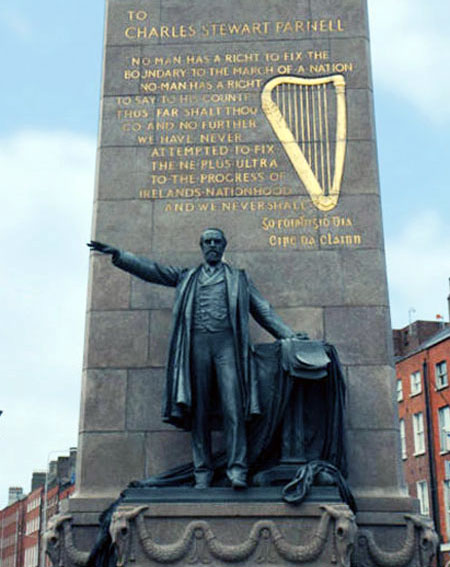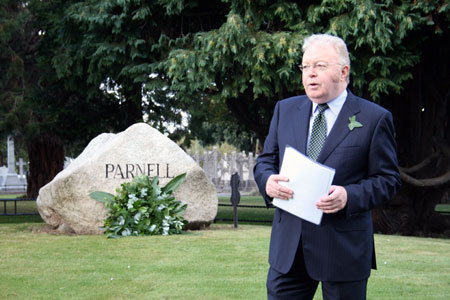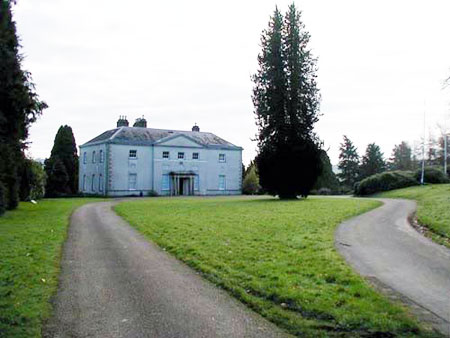Parnell
Charles Stewart Parnell was born into a Protestant aristocratic and land-owning family at Avondale, Co. Wicklow on 27 June 1846, the seventh child of John Henry Parnell and Delia Tudor Stewart (the daughter of an American naval hero, Commodore Charles Stewart). His early schooling was in England where he attended a girls’ school in Yeovil, Somerset. He contracted typhoid and was brought home for private tuition. He later went to a school in Kirk Langley, Derbyshire, from which he was expelled; and then to Great Ealing School. When his father died in 1859 the young Parnell inherited the Avondale estate. The family lived in a succession of homes in the Dublin area during the 1860s. Parnell also attended Rev. Whishaw’s Academy in Chipping Norton. He went on to Magdalene College, Cambridge, but did not graduate.
In 1874, at the age of twenty-seven, Parnell abruptly resolved to enter Home Rule politics and in the following year he was elected to represent Co. Meath in the House of Commons and joined the Home Rule party led by Isaac Butt. In the beginning he was a rather reluctant speaker and contributed little in the way of debate during his first year in the Commons. He soon gained a mastery of parliamentary procedure and his powers of leadership soon became evident. He established himself as an advanced nationalist when he joined in obstructionist tactics in parliament with Joseph Biggar, a determined and rugged Belfast-born nationalist and member of the Supreme Council of the IRB. Parnell seems to have relied heavily on the support of Fenian sympathisers. One of his earliest remarks in Parliament was in support of the ‘Manchester martyrs’. These were three Irishmen hanged in Manchester in November 1867 for killing a policeman during a botched Fenian escape. Parnell worked hard to secure amnesty for the remaining prisoners (including Michael Davitt) who had been imprisoned for gun running in 1870.
In 1877 Parnell became President of the Fenian-controlled Home Rule Confederation of Great Britain, against the wishes of the party leader, Isaac Butt. By this time Parnell had won the support of the leading Irish-American republican organisation, Clan na Gael. The Catholic bishops were highly suspicious of him, partly because of his politics, partly because he was Protestant. They were very unhappy about his parliamentary obstructionism and his connections with the Fenians. For his part, Parnell tried to win them over by supporting their demand for state aid for Catholic schools and for a Catholic University.
He identified and highlighted most forcibly the tenant farmers’ grievances about the system of land-holding at the Westport land meeting in June 1879. Here he gave his most famous speech:
‘You must show the landlords that you intend to keep a firm grip on your homesteads and lands. You must not allow yourselves to be dispossessed as you were dispossessed in 1847’.
The National Land League was founded in October 1879, on Michael Davitt’s initiative. The League aimed to improve conditions for tenant farmers, demanding, in the short term, the ‘three Fs—fair rent, fixity of tenure and freedom of sale’. In the long term the League hoped to abolish the landlord system altogether and make the tenants the owners of their farms through state–aided land purchase. Parnell was elected the first President of the Land League at a meeting in the Imperial Hotel, Dublin, on 21 October 1879. Davitt’s passion for social justice inspired him to found the Land League but Parnell’s leadership of agrarianism in the country and his parliamentary skill in Westminster made the Land League a powerful and revolutionary force that had to be reckoned with in Irish politics.
Shortly after the Land League was founded, Parnell went to the United States to raise money. He travelled 16,000 miles in the United States and Canada, spoke in more than 60 cities and raised about £60,000 for famine relief and £12,000 for the League. In early 1880 the Conservative Prime Minister, Disraeli, called a general election. The election was a triumph for Parnell who was elected for three constituencies, Meath, Mayo and Cork city. He opted to represent Cork which he did for the rest of his life. He was proposed as leader of the Irish Parliamentary Party and despite the opposition of moderate Home Rulers, Fenians, and the Catholic Church he won. Parnell’s supporters were united, his opponents were not.
In April 1881, Gladstone introduced a Land Bill which gave tenants the three Fs. This Act brought improvements for tenants and it was welcomed by the better-off tenants who would benefit from it but it excluded almost 280,000 tenants who were either leaseholders or were in arrears. Parnell knew that his followers were divided over the Act and in an effort to prevent his movement from breaking up he matched his speeches to his audiences. He advised the better-off tenants ‘to test the Act’ and he pointed out its weaknesses to those who did not benefit from it. The Act contained land purchase clauses and 731 tenants bought land under its provisions.
On 13 October 1881, Parnell was arrested under the Coercion Acts. He wrote to Katharine O’Shea when he was taken:
‘Politically it is a fortunate thing for me that I have been arrested, as the movement is breaking fast and all will be quiet in a few months, when I shall be released’.
He knew that he could not be blamed for the break up of the Land League which he expected to result from the divisions among tenants over the Land Act. Instead he and other Land League leaders were lodged in Kilmainham Gaol—agrarian martyrs. From there they issued the ‘No Rent Manifesto’, calling on the tenants not to pay rent and to boycott the Land Courts until the ‘suspects’ were released. It was said that Parnell, at the time of his arrest, remarked that ‘Captain Moonlight’ would take his place, and so it proved. By the start of 1882, Irish agrarian unrest escalated to unprecedented levels (3,433 episodes of agrarian violence were recorded) and it was clear to both Gladstone and Parnell that it was time to reach a compromise.
The Kilmainham Treaty was agreed. The agreement was that Gladstone would amend the Land Act of 1881 to include tenants in arrears and leaseholders; drop coercion; and release ‘suspects’ in police custody. In return, Parnell would help to pacify the people of Ireland and co–operate with the Liberal Party in forwarding Liberal principles and measures of general reform. Parnell was released on 2 May 1882 and crossed directly to England where he made a dramatic appearance in the House of Commons.
On 6 May 1882, Lord Frederick Cavendish, the Chief Secretary, and his Permanent Under-Secretary, Thomas Burke, were stabbed to death in the Phoenix Park, Dublin, by the Invincibles, a group of extreme nationalist assassins. Parnell was deeply shaken by the assassinations, even to the extent of writing to Gladstone offering to resign as an MP—an offer rejected by Gladstone.
Parnell now resolved on a different course. In October 1882 he effectively replaced the semi-revolutionary National Land League movement with the disciplined pledge-bound Irish National League that was centralised under his own control and that of his faithful followers. It superseded both the Land League and the Home Rule League and, by 1886, it had over 1,200 branches. The National League was to serve the parliamentary party well and to act as an efficient party machine dedicated to choosing candidates for election, raising funds for the party, and getting the voters out to vote on election day. It turned the Home Rule movement into a modern united political party that was organised at local, county, national, and parliamentary party level. It controlled political expression and national sentiment to a large extent and was politically effective. It paid its MPs who needed financial support and that, no doubt, helped to secure their loyalty. By the next general election, in 1885, Parnell and his supporters controlled the National League to such an extent that only candidates approved by them could be elected as Home Rulers. Gladstone himself was impressed by the regular attendance and the disciplined voting of Parnell’s post-1885 party.
Parnell’s first objective was Home Rule; land law reform was a poor second. As early as October 1880, in a speech in Galway, he had said of his role in the land war: ‘I would not have taken off my coat and gone to this work if I had not known that we were laying the foundation in this movement for the regeneration of our legislative independence’. He now, in 1882, focused on constitutional politics and turned away from revolutionary groups. He devoted himself to his main political ambition, that of winning Home Rule by negotiation with the political parties in Westminster. The land question became less pressing. Parnell was alarmed by the militancy of the women of the Ladies’ Land League which had taken over the work of the imprisoned leaders, and on his release from prison, in May 1882, he set about dissolving the organisation (August 1882). This was done in a humiliating way, by cutting off its funds, which caused bitterness and resentment among the women and it is said that his sister Anna, one of the founders of the Ladies’ Land League, never spoke to him again.
The 1885 general election was a triumph for Parnell and for the National League. Parnell, with a party of 86 Home Rule MPs, held the balance of power at Westminster. When it became clear that Gladstone favoured Home Rule for Ireland the Home Rule party switched their support and put the Liberals into power, in January 1886. Gladstone had not yet persuaded enough members of his party of the merits of Home Rule but nevertheless he introduced a Home Rule Bill in May 1886. It was opposed by Unionists in Ireland, Conservatives in Britain, and by the right-wing Whigs and the left-wing radicals (led by Joseph Chamberlain) of Gladstone’s own Liberal party. The Bill was defeated, in June 1886. In the ensuing election of 1886 the Liberals fell from power.
Parnell and the Home Rule party remained strong. Gladstone’s support for Home Rule was regarded in Ireland as a triumph and indeed Parnell’s success in persuading Gladstone, one of the greatest leaders and parliamentarians of the age, of the merits of Home Rule, was a great achievement. Parnell had ‘set the Home Rule argument on its legs’, as Gladstone said much later. Parnell’s success in 1885 and 1886 and the danger represented by his 86 MPs ‘converted’ the Tories to ‘killing Home Rule with kindness’, another great achievement that would bring great benefits to Ireland.
In 1887 the Times published a series of articles under the title ‘Parnellism and Crime’, in which the Home Rule leaders were accused of complicity in crimes and outrages during the Land War. Parnell was accused of supporting the assassination of the Chief Secretary of Ireland in the Phoenix Park. The evidence against him turned out to be letters forged by the journalist Richard Piggott who did it for money. Piggott later shot himself in Spain after being confronted by British police in the spring of 1888. Parnell’s innocence served to unite all shades of nationalist opinion around him and enhanced his standing with a British public that had been very hostile towards him. He was now at the pinnacle of his career, the ‘uncrowned king of Ireland’.
In 1890, Captain William O’Shea, a former member of Parnell’s party, got a divorce from his wife, Katharine, with whom Parnell had been living (and who bore him two daughters, Claire and Katharine). Captain O’Shea, in an effort to benefit from the will of Katharine’s wealthy aunt, made the case public. This was a serious blow to Parnell’s political ambitions and to his career. Most of his party deserted him and he rapidly lost public support. Many took the view that he was no longer a fit person to lead the Irish Parliamentary Party. Michael Davitt’s call for Parnell’s temporary retirement in Labour World, 20 November 1890, was supported by many. Gladstone informed the party Chairman that there could be no alliance with the Liberals while Parnell remained leader. Parnell, a proud and passionate man beneath his aloof exterior, refused to stand down, and this produced a bitter split in the parliamentary party on 6 December 1890 when Justin McCarthy led 44 members out, leaving Parnell with 27. Parnell went on to suffer several by-election defeats. He continued to fight for the leadership and he made many ambiguous speeches that seemed to appeal to the Fenian tradition. Davitt called this period ‘the crowning disgrace of his career’. The Catholic hierarchy issued their condemnation in June 1891. They stated that Parnell,
‘by his public misconduct, has utterly disqualified himself to be … leader’.
Parnell’s health deteriorated in 1891. Despite illness, and a warning from his doctor not to do so, he kept an engagement to speak at Creggs, Co. Galway, 27 September 1891. He did so in torrential rain, returned to Dublin, and then to Brighton. He did not recover and died suddenly at Brighton on 6 October 1891, at the age of forty-five, just five months after he had married Katharine O’Shea. James Joyce was to describe him as ‘strong to the point of weakness.’ His funeral to Glasnevin Cemetery, Dublin, 11 October, was attended by nearly 250,000 people. A monument was erected in Sackville Street (now O’Connell Street) and Great Britain Street was renamed Parnell Street in his honour.



